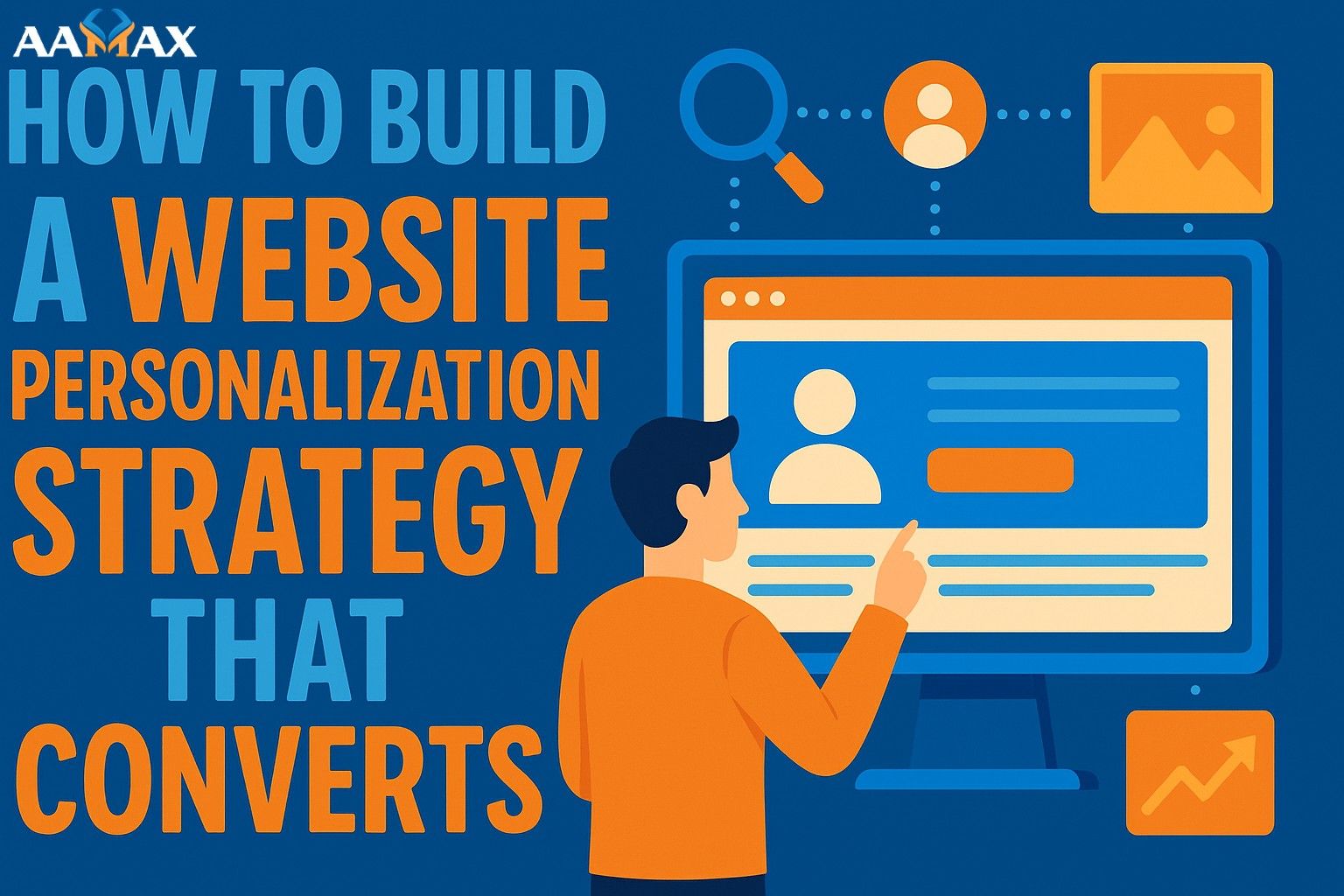
How to Build a Website Personalization Strategy That Converts
Building a website personalization strategy that actually converts is no longer a luxury; it is the backbone of modern digital marketing and user experience. Users now expect websites to understand their needs and serve content that is relevant to their stage in the customer journey. Done well, personalization increases conversions, reduces bounce rates, and improves customer loyalty.
In this guide, we will walk you through how to create a powerful website personalization strategy, covering frameworks, data collection, segmentation, personalization tactics, and testing for continual improvement.
Why Website Personalization Matters
Today’s users are overwhelmed with generic websites and irrelevant offers. Personalization allows you to:
-
Guide visitors to the right content based on behavior.
-
Reduce decision fatigue by presenting focused offers.
-
Create a better customer journey aligned with user intent.
-
Drive higher conversion rates and customer satisfaction.
In fact, studies show that personalized websites can increase conversion rates by up to 202% compared to non-personalized sites.
Step 1: Define Your Personalization Objectives
Before you jump into tools and implementation, define what personalization success looks like for your website. Consider:
-
Do you want to increase product demo sign-ups?
-
Are you looking to reduce cart abandonment rates?
-
Do you aim to improve average order value (AOV)?
Link these objectives with measurable KPIs such as conversion rate, bounce rate, page depth, or time on page.
Step 2: Collect and Organize User Data
Personalization requires robust data collection. You can use:
-
Behavioral data: pages visited, time spent, clicks.
-
Demographic data: location, device, language preferences.
-
CRM and first-party data: purchase history, email interactions.
-
Intent data: search queries, site searches, or category interests.
Using tools like Google Analytics, Hotjar, or advanced CDPs can centralize this data for easier segmentation.
Step 3: Segmentation: The Heart of Personalization
Effective personalization starts with clear audience segmentation.
Segmentation ideas include:
-
New vs. returning visitors: Display welcome offers for new visitors and loyalty discounts for returning ones.
-
Location-based: Showcase location-relevant services or shipping options.
-
Behavior-based: Personalize product recommendations based on browsing patterns.
-
Referral source: Customize landing pages based on whether traffic came from social media, email, or paid ads.
Each segment should align with your objectives, making it easier to map personalized content and CTAs that speak directly to the segment’s needs.
Step 4: Choose the Right Personalization Tools
Your website personalization strategy will require tools capable of dynamic content rendering, tracking, and testing. Tools like:
-
Optimizely or VWO: for A/B and multivariate testing.
-
HubSpot CMS: for behavioral and contextual personalization.
-
Dynamic Yield or Adobe Target: for enterprise personalization needs.
Ensure your CMS and backend can handle dynamic content efficiently without sacrificing site speed, which is critical for conversions.
Step 5: Develop Personalized Content and Experiences
Personalization is not just about product recommendations. It includes:
-
Dynamic CTAs: Display different calls to action depending on the visitor’s journey stage.
-
Tailored messaging: Adjust copy to match the segment’s pain points or desires.
-
Personalized product recommendations: Suggest products based on previous browsing or cart items.
-
Content personalization: Show blog articles or resources aligned with the visitor’s interests.
For example, if a user has shown interest in “affordable hosting services,” your homepage hero section could present a personalized offer for budget-friendly hosting.
Step 6: Testing and Optimization
The most effective personalization strategies evolve through iterative testing and refinement.
-
A/B Testing: Test different versions of personalized content to see which converts best.
-
Multivariate Testing: Explore combinations of content, CTAs, and visuals.
-
Heatmaps & Session Recordings: Use tools like Hotjar to see how personalized content is performing.
Analyze which segments engage the most with personalized elements and adjust your strategy accordingly to maximize ROI.
Step 7: Respect Privacy and Compliance
While personalization enhances user experience, it is crucial to balance it with user privacy. Ensure compliance with:
-
GDPR (General Data Protection Regulation)
-
CCPA (California Consumer Privacy Act)
-
Transparent opt-in mechanisms for data collection.
-
Clear privacy policies explaining data use.
Always allow users to control the level of personalization they wish to receive to build trust.
Advanced Personalization Strategies to Increase Conversions
Once you have your foundational personalization strategy in place, consider advanced techniques to take conversions further:
1. Predictive Personalization Using AI
Machine learning models can analyze user behavior and predict what content or products a user is likely to engage with. Tools like Dynamic Yield or custom AI models can help you implement predictive personalization, showing personalized recommendations even for first-time visitors based on similar user patterns.
2. Personalized Email and Onsite Integration
Align your website personalization strategy with your email marketing campaigns. If a user clicks an email about a specific service, ensure your landing page continues the personalized journey, highlighting that service or related offers.
3. Exit-Intent Personalization
Using exit-intent popups tailored to what the visitor was browsing can help capture abandoning visitors. For example, offering a discount for a product left in the cart or providing a free guide related to the service they viewed.
4. Personalization in Checkout Flow
Show personalized upsells or cross-sells during checkout to increase average order value. Ensure these recommendations are non-intrusive and contextually relevant to avoid disrupting the checkout experience.
Measuring the Success of Your Personalization Strategy
Track KPIs aligned with your personalization objectives:
-
Conversion Rate Changes
-
Bounce Rate Reduction
-
Increase in Average Session Duration
-
Higher Click-through Rates (CTR) on Personalized CTAs
-
Improved Customer Retention Rates
Use these insights to double down on what’s working and improve areas where personalization isn’t driving results.
Common Mistakes to Avoid in Website Personalization
-
Over-personalization: Bombarding users with too many personalized elements can feel invasive.
-
Ignoring Data Accuracy: Using outdated or inaccurate data can lead to irrelevant personalization, reducing trust.
-
Neglecting Mobile Personalization: Mobile visitors often have different needs; ensure your personalization strategy adapts to mobile users.
-
Setting and Forgetting: Personalization requires continuous testing and optimization.
Tools and Plugins to Simplify Website Personalization
If you are using WordPress, consider plugins like:
-
If-So Dynamic Content
-
Logic Hop
-
Elementor Pro Dynamic Content
For Shopify, use apps like:
-
LimeSpot Personalizer
-
Recom.ai
For custom websites, your development team can integrate APIs with personalization engines or build custom logic for dynamic content rendering.
Why Work with Experts to Build a Personalization Strategy
Personalization is both a technical and strategic undertaking. It involves:
- Integration with backend systems.
- Design and copy aligned with customer psychology.
- Continuous testing for performance improvement.
Working with experts like AAMAX can help you implement a conversion-focused website personalization strategy efficiently. AAMAX is a full-service digital marketing company offering Web Development, SEO, and Digital Marketing Services, ensuring your personalized website is aligned with your business objectives and optimized for conversions.
Final Thoughts: Personalization is a Journey, Not a One-Time Task
Building a website personalization strategy that converts requires planning, data collection, smart segmentation, dynamic content implementation, testing, and continuous iteration. Personalization is not about showing a user their name on a page; it’s about creating meaningful, relevant experiences that guide them to take action.
As competition grows and user expectations rise, personalization will differentiate your brand and keep your visitors engaged and converting.
Start small, measure, and scale your personalization efforts to build a conversion-driven website that feels personal, relevant, and human.







